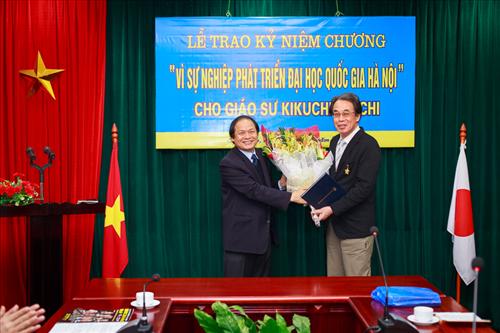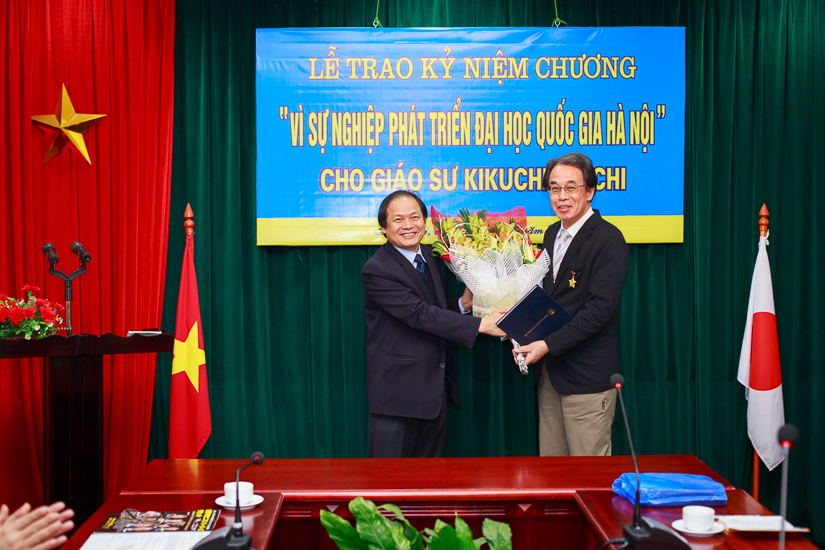

Prof. Dr. Nguyen Van Khanh (left, Principal) presented the Commemorative Medal and flowers to congratulate Prof. Kikuchi Seiichi. (Photo: Thanh Long/USSH)
The ceremony to award the Medal to Prof. Kikuchi Seiichi was attended by many Vietnamese historical and archaeological researchers who have been his close colleagues and friends for many years. Associate Professor Dr. Nguyen Van Kim (Vice Rector of the University of Social Sciences and Humanities) reviewed the journey of more than 20 years of Prof. Kikuchi Seiichi's association with the field of Vietnamese Archaeology.
Prof. Kikuchi Seiichi was born in 1954 in Gunma Prefecture (Japan). He fell in love with the country and culture of Vietnam at a young age and first came to Vietnam in 1979. The trip left him with many profound memories and the opportunity led him to read the book "Basis of Archaeology" compiled by the late Prof. Tran Quoc Vuong and Prof. Ha Van Tan. Returning to Japan, Prof. Kikuchi was determined to learn Vietnamese on his own and persistently used a Vietnamese dictionary to translate the book into Japanese for many years. This is one of the first books on Vietnamese archaeology published in Japan.
In 1993, young university lecturer Kikuchi Seiichi decided to go to Vietnam to learn Vietnamese and directly participate in surveys and coordinate archaeological excavations at many relic sites in Vietnam. The scientist quickly integrated with the Vietnamese historical and archaeological research community, proactively learned and had close relationships with many famous scientists such as Prof. Phan Huy Le, Prof. Ha Van Tan, Prof. Luong Ninh, Prof. Diep Dinh Hoa...
After the 1990 international conference on the ancient town of Hoi An, with strong support and assistance from Japan, Hoi An became a symbol of close cooperation between the two countries' research communities in general and the archaeology community in particular. Together with his colleagues, Prof. Kikuchi Seiichi began to research the ancient town of Hoi An in a fundamental and comprehensive way, placing Hoi An in the historical context of the Central trading port of the Dang Trong region as well as the regional context. The parallel coordination between archaeological history and architecture has brought very good results: Hoi An has become a world cultural heritage and one of the two heritages of Quang Nam province.
Since 1993, Prof. Kikuchi Seiichi has published many scientific works related to the ancient town of Hoi An at many scientific conferences, and compiled those studies in the monograph "History of the ancient town of Hoi An" published in Vietnamese and Japanese. Passionate about research for many years, Prof. Kikuchi Seiichi has built a close relationship and emotional attachment with the community of residents of the ancient town. In fact, many people in the Hoi An urban area know and are familiar with the image of the Japanese archaeologist during his long field trips here.
Along with the ancient town of Hoi An, Professor Kikuchi Seiichi paid special attention to the relationship between the ancient town of Hoi An and the trading ports of the Central region, thus spending a lot of time to survey the trading ports from the North Central to the South Central. The Professor was also interested in the exchange relationship between the commercial centers in the coastal and estuary areas. Following the traces of the trade routes between Japan and Asia, the Professor had in-depth research on Japanese Hizen ceramics in Bao Lap (Lam Dong), and at the same time had remarkable views on the history of formation and development of Hizen ceramics as well as the history of exporting Hizen ceramics abroad by the Japanese in the 17th century.
Evaluating the contributions and attachment of Japanese scientists to Vietnam, Associate Professor Dr. Nguyen Van Kim said: "With his love for Vietnamese culture and history and his passion and concern for research, Professor Kikuchi Seiichi has devoted himself to and made great contributions to Vietnamese archaeology. Professor Kikuchi's research on ancient towns and villages in many localities of Vietnam such as Hoi An ancient town, Ho Dynasty citadel, Duong Lam ancient village (Son Tay), Phuoc Tich ancient village (Hue) ... has made an important contribution in proposing the recognition of national cultural heritages and world cultural heritages.".
In addition, he has made an important contribution to promoting the cooperative relationship between Vietnamese scientists and Japanese scientists; has many initiatives in organizing cultural exchanges, seminars, and scientific forums between Vietnam and Japan and internationally. The Professor's contributions are closely linked to the development of the University of Social Sciences and Humanities, VNU, and specifically the Archaeology Department of the University.
Happy and moved by the affection that Vietnamese colleagues and friends gave, Professor Kikuchi said: “I have been attracted to Vietnam since I was a child, and when I had the opportunity to go abroad for work and to expand my knowledge, Vietnam was the first destination. I wanted to use Archaeology to understand Vietnam better.".
He also shared many memories of self-studying Vietnamese through dictionaries and going through many difficulties over many years to be able to publish the first book on Vietnamese archaeology in Japan. That was the first opportunity that led to his attachment to most of his life and career with archaeological research in Vietnam.
At the age of 60, Prof. Kikichi Seiichi surprised listeners with his energy and enthusiasm for research projects and promoting academic exchanges in Vietnam in the coming years. First is the plan to build a student and lecturer exchange relationship between Showa Women's University and the University of Social Sciences and Humanities. Next is the idea of seeking support from corporations and Japanese exchange funds to build a center for historical exchange cooperation between Vietnam and Japan located at the University of Social Sciences and Humanities, VNU. This will be a specific address to implement cooperation activities and mutual support in research between Vietnamese and Japanese scientists, towards building a modern and internationally integrated Archaeology industry in Vietnam. Another major concern of Prof. Kikuchi Seiichi is to promote the publication and publication of valuable documents related to the Vietnam - Japan exchange and cooperation relationship throughout the centuries. Finally, Professor Kikuchi Seiichi shared that he wants to start compiling a Vietnamese archaeological dictionary in three languages: English - Vietnamese - Japanese as a foundation tool for archaeological research in Vietnam.
Japanese scientist said: “Through my professional work, I want to contribute my efforts to the development of research exchange relations between the two countries. In particular, I want the youth of the two countries to have the opportunity to learn about each other, find the beauty and precious values in the historical culture of the two countries, to appreciate more what has been and together contribute to the development of the relationship between Vietnam and Japan in the future.".
Author:Thanh Ha
Newer news
Older news